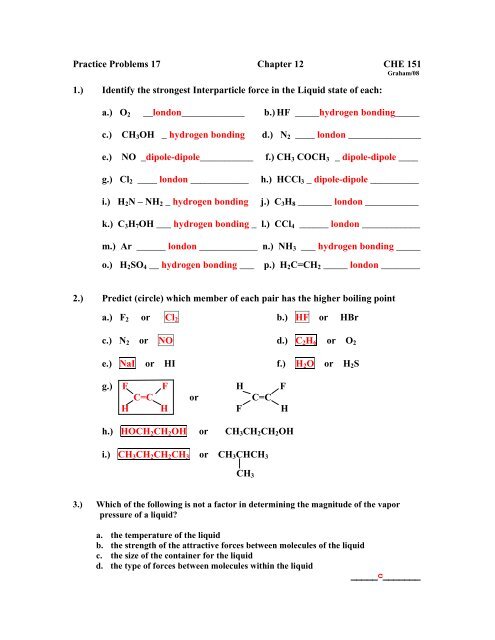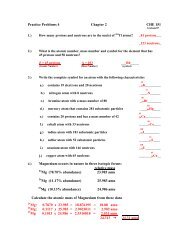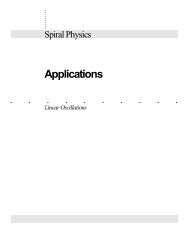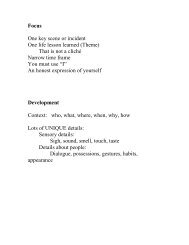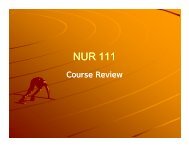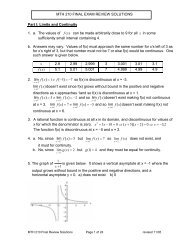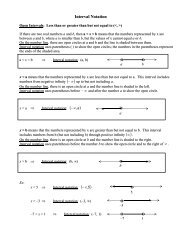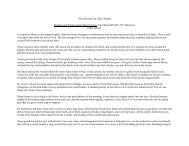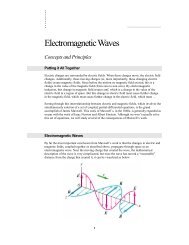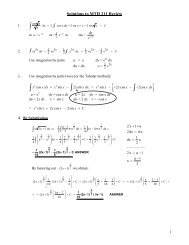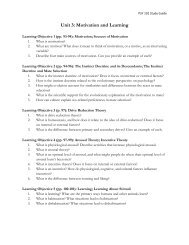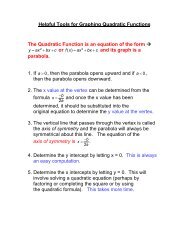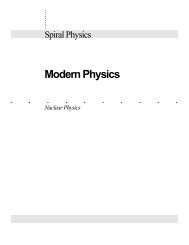Practice Problems 2
Practice Problems 2
Practice Problems 2
Create successful ePaper yourself
Turn your PDF publications into a flip-book with our unique Google optimized e-Paper software.
<strong>Practice</strong> <strong>Problems</strong> 17 Chapter 12 CHE 151<br />
Graham/08<br />
1.) Identify the strongest Interparticle force in the Liquid state of each:<br />
a.) O 2 __london_____________ b.) HF _____hydrogen bonding_____<br />
c.) CH 3 OH _ hydrogen bonding<br />
e.) NO _dipole-dipole___________<br />
g.) Cl 2 ____ london ____________<br />
i.) H 2 N – NH 2 _ hydrogen bonding<br />
d.) N 2 ____ london _______________<br />
f.) CH 3 COCH 3 _ dipole-dipole ____<br />
h.) HCCl 3 _ dipole-dipole __________<br />
j.) C 3 H 8 _______ london ___________<br />
k.) C 3 H 7 OH ___ hydrogen bonding _ l.) CCl 4 ______ london ____________<br />
m.) Ar ______ london ____________ n.) NH 3 ___ hydrogen bonding _____<br />
o.) H 2 SO 4 __ hydrogen bonding ___ p.) H 2 C=CH 2 _____ london ________<br />
2.) Predict (circle) which member of each pair has the higher boiling point<br />
a.) F 2 or Cl 2 b.) HF or HBr<br />
c.) N 2 or NO d.) C 2 H 6 or O 2<br />
e.) NaI or HI f.) H 2 O or H 2 S<br />
g.) F F H F<br />
C=C or C=C<br />
H H F H<br />
h.) HOCH 2 CH 2 OH or CH 3 CH 2 CH 2 OH<br />
i.) CH 3 CH 2 CH 2 CH 3 or CH 3 CHCH 3<br />
CH 3<br />
3.) Which of the following is not a factor in determining the magnitude of the vapor<br />
pressure of a liquid<br />
a. the temperature of the liquid<br />
b. the strength of the attractive forces between molecules of the liquid<br />
c. the size of the container for the liquid<br />
d. the type of forces between molecules within the liquid<br />
_____c_______
4.) A nonvolatile liquid would<br />
a. have weak attractive forces between molecules<br />
b. evaporate rapidly at room temperature<br />
c. have a high vapor pressure at room temperature<br />
d. be a very "explosive" substance<br />
e. have strong attractive forces between molecules _____e_________<br />
5.) Which statement about the boiling point of water is incorrect<br />
a. The boiling point is greater than 100 o C in a pressure cooker.<br />
b. The boiling point is less than 100 o C for locations at low elevations.<br />
c. At sea level and at a pressure of 760 mm Hg, the boiling point is 100 o C.<br />
d. In a pressure cooker, shorter cooking times are required due to the change in<br />
boiling point.<br />
d. The boiling point is a consequence of a molecule's intermolecular forces.<br />
____b__________<br />
6.) Which of the following statements is correct<br />
a. dipole-dipole interactions occur only between nonpolar molecules<br />
b. a hydrogen bond is an extremely weak dipole-dipole interaction<br />
c. London forces are "instantaneous" dipole-dipole interactions<br />
d. Hydrogen bonding occurs between any two hydrogen-containing molecules<br />
____c__________<br />
7.) Which of the following substances would be expected to have the lowest boiling point<br />
a. a nonpolar liquid<br />
b. a polar liquid with hydrogen bonding<br />
c. a polar liquid with weak dipole-dipole interactions<br />
d. a nonvolatile liquid<br />
e. a polar liquid with strong dipole-dipole interactions ____a_________<br />
8.) Which of the following compounds is incorrectly matched with the predominant<br />
intermolecular force associated with that compound in the liquid state.<br />
compound intermolecular force<br />
a. CCl4 dipole-dipole interactions<br />
b. H2O hydrogen bonding<br />
c. BF3 London forces<br />
d. NH3 hydrogen bonding<br />
e. Br2 London forces ____a________
9.) The normal boiling point of a substance is determined by its molecular mass and its<br />
intermolecular forces. Considering these two factors, predict the order of increasing<br />
boiling points for the following substances: H2, NaCl, H2O, and CO2.<br />
a. CO2 < H2 < NaCl < H2O<br />
b. H2 < CO2 < H2O < NaCl<br />
c. H2O < NaCl < CO2 < H2<br />
d. H2 < NaCl < H2O < CO2<br />
e. NaCl < H2O < CO2 < H2 ____b________<br />
10.) The vapor pressure of PBr 3 reaches 400 mm Hg at 150 o C. The vapor pressure of PCl 3<br />
reaches 400 mm Hg at 57 o C.<br />
a. At 100 o C which substance should evaporate at the faster rate ____PCl 3 _____<br />
b. Which substance should have the lower normal boiling point ____ PCl 3 ____<br />
c. Which substance should have the weaker intermolecular forces ____ PCl 3 ___<br />
d. At 50 o C which substance should have the higher vapor pressure ____ PCl 3 ____<br />
11.) Consider the phase diagram shown below.<br />
a. What phase(s) is/are present at point A ___liquid_____________________<br />
b. What phase(s) is/are present at point B _solid, liquid, gas_______________<br />
c. Name point C and explain its significance. _critical point- above the critical<br />
temp., substance cannot be liquefied, regardless of pressure._________________<br />
d. Starting at D, if the pressure is lowered while the temperature remains constant,<br />
describe what will happen. D = solid phase. As P is lowered, solidgas dividing<br />
line is reached. Solid will sublime. ___________
12.) Which of the following atoms should have the greatest polarizability<br />
A. F<br />
B. Br<br />
C. Po<br />
D. Pb<br />
E. He ____D________<br />
13.) In which of the following compounds will the molecules not form hydrogen<br />
bonds with each other<br />
14.) Which of the following pairs is arranged with the particle of higher<br />
polarizability listed first<br />
_____c______<br />
A. Se 2- , S 2-<br />
B. I, I -<br />
C. Mg 2+ , Mg<br />
D. Br, I<br />
E. None of these choices is correct ____A_______<br />
15.) Select the pair of substances in which the one with the higher vapor pressure<br />
at a given temperature is listed first.<br />
A. C 7 H 16 , C 5 H 12<br />
B. CCl 4 , CBr 4<br />
C. H 2 O, H 2 S<br />
D. CH 3 CH 2 OH, CH 3 -O-CH 3<br />
E. Xe, Kr _____B_______
16.) Which of the following should have the highest surface tension at a given<br />
temperature<br />
A. CH 4<br />
B. CF 4<br />
C. CCl 4<br />
D. CBr 4<br />
E. CI 4 _____E________<br />
17.) Which of the following should have the highest surface tension at a given<br />
temperature<br />
18.) When the adhesive forces between a liquid and the walls of a capillary tube<br />
are greater than the cohesive forces within the liquid<br />
_____d_____<br />
A. the liquid level in a capillary tube will rise above the surrounding liquid and<br />
the surface in the capillary tube will have a convex meniscus.<br />
B. the liquid level in a capillary tube will rise above the surrounding liquid and<br />
the surface in the capillary tube will have a concave meniscus.<br />
C. the liquid level in a capillary tube will drop below the surrounding liquid and<br />
the surface in the capillary tube will have a convex meniscus.<br />
D. the liquid level in a capillary tube will drop below the surrounding liquid and<br />
the surface in the capillary tube will have a concave meniscus.<br />
E. None of these will occur.<br />
_____B_________<br />
19.) Which of the following factors contributes to a low viscosity for a liquid<br />
A. low temperature<br />
B. spherical molecular shape<br />
C. hydrogen bonding<br />
D. high molecular weight<br />
E. high boiling point ____B_______
20.) Which of the following pairs of substances is arranged so that the one with<br />
higher viscosity is listed first<br />
21.) Which of the following liquid substances would you expect to have the lowest<br />
surface tension<br />
____b______<br />
A. Pb<br />
B. CH 3 OCH 3<br />
C. HOCH 2 CH 2 OH<br />
D. H 2 O<br />
E. CH 3 CH 2 OH ____B_______<br />
22.) Which one of the following substances does not exist in the indicated solid<br />
type<br />
A. graphite - network<br />
B. Na - metallic<br />
C. SiO 2 - molecular<br />
D. NaCl - ionic<br />
E. diamond – network _____C______<br />
23.) When liquid bromine is cooled to form a solid, which of the following types of solid<br />
would it form<br />
A. atomic<br />
B. metallic<br />
C. molecular<br />
D. ionic<br />
E. covalent network _____C______
24.) For the solid forms of the following elements, which one is most likely to be of<br />
the molecular type<br />
A. Xe<br />
B. C<br />
C. Pb<br />
D. S<br />
E. Cr _____D_____<br />
25.) Of the five major types of crystalline solid, which would you expect each of<br />
The following to form (e.g., H 2 O: molecular)<br />
A. Sn ____metallic__________<br />
B. Si ____network covalent__<br />
C. KCl ____ionic____________<br />
D. Xe _____atomic__________<br />
E. F 2 ____molecular_________


